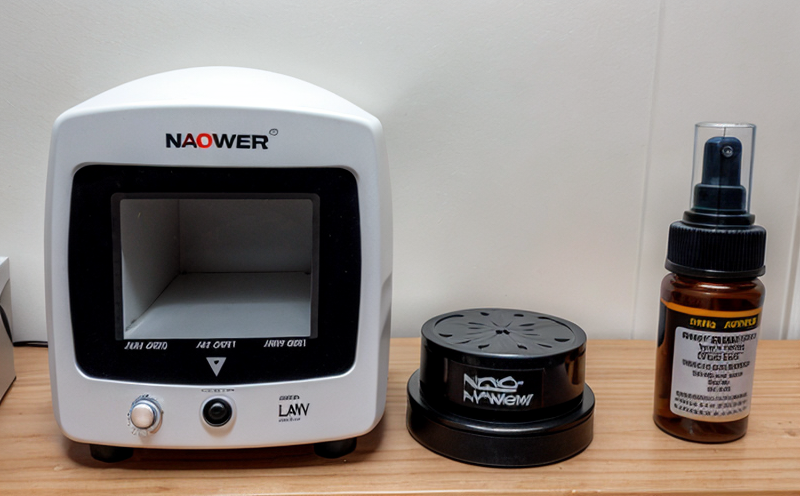ISO 13322 Image Analysis for Nanoparticle Shape and Distribution
The ISO 13322 standard is a cornerstone in the field of nanomaterials testing, specifically designed to analyze nanoparticle shape and distribution through image analysis. This service is crucial for ensuring that nanoparticles meet regulatory requirements and industry standards, thereby enhancing product safety and performance. Nanoparticles are widely used across various sectors including pharmaceuticals, cosmetics, electronics, and environmental remediation due to their unique physical properties.
The testing procedure involves the use of advanced imaging techniques such as scanning electron microscopy (SEM) and transmission electron microscopy (TEM). These instruments capture high-resolution images that provide detailed insights into nanoparticle morphology. The analysis then proceeds by identifying key parameters like aspect ratio, sphericity, and size distribution, which are critical for understanding the behavior and potential impact of nanoparticles in different applications.
Understanding these characteristics is paramount as it directly influences how particles interact with biological systems or their efficiency in catalytic processes. For instance, in pharmaceuticals, particle shape can affect drug delivery mechanisms while in electronics, it impacts conductivity and surface area. Thus, accurate characterization through ISO 13322 ensures that nanomaterials are optimized for desired applications.
Preparation of the sample is a meticulous process requiring precise handling to prevent any alteration of the nanoparticle properties. Typically, this involves dispersing the nanoparticles onto a suitable substrate using controlled procedures to ensure uniform coverage and minimal agglomeration. Once prepared, the samples undergo rigorous imaging under SEM or TEM, depending on the desired resolution.
The analysis itself is complex yet highly standardized. Imaging software processes the captured images to quantify various morphological features by applying algorithms tailored for particle recognition and measurement. This involves identifying individual particles within an image, measuring their diameters, lengths, widths, and other relevant dimensions. The software also calculates statistical parameters such as mean diameter, distribution width, and percentiles, providing a comprehensive description of the nanoparticle population.
The results from this analysis are invaluable for researchers developing new nanomaterials or optimizing existing ones. It allows them to make informed decisions regarding processing conditions that yield particles with desired shapes and distributions. Compliance officers benefit too by ensuring products meet stringent regulatory standards set forth by bodies like the European Commission, FDA, or other national authorities.
For R&D engineers, this service offers a tool for innovation by enabling exploration into novel particle designs that could offer advantages in specific fields. It also aids procurement teams in assessing suppliers' capabilities and reliability when sourcing nanomaterials.
Applied Standards
| Standard | Description | Purpose |
|---|---|---|
| ISO 13322:2015 | Determination of particle size distribution by laser diffraction and light scattering. | To provide a means for determining the particle size distribution in powders, liquids, or slurries using laser diffraction and light scattering techniques. |
| ISO 13328:2014 | Determination of particle size distribution by sedimentation. | To provide a means for determining the particle size distribution in powders, liquids, or slurries using sedimentation methods. |
While ISO 13322 focuses on image analysis, it is part of a broader suite of standards aimed at ensuring accurate characterization of nanomaterials. These include laser diffraction and sedimentation techniques which complement each other in providing comprehensive information about nanoparticle properties.
Why Choose This Test
- Achieves high precision in measuring particle size distribution.
- Precisely determines shape parameters like aspect ratio and sphericity.
- Ensures compliance with international regulatory requirements.
- Fast turnaround times for critical projects.
- Accurate results that enhance product quality and safety.
- Expertise in handling complex nanomaterials.
- State-of-the-art instrumentation supported by experienced staff.
The combination of these factors makes ISO 13322 image analysis an indispensable tool for any organization dealing with nanotechnology, ensuring reliable and reproducible results that are essential for innovation and compliance.
Environmental and Sustainability Contributions
Nanoparticle characterization through ISO 13322 contributes significantly to environmental sustainability by promoting responsible use of nanomaterials. Accurate knowledge about particle size, shape, and distribution helps in minimizing ecological impacts during production processes as well as end-of-life disposal scenarios.
By ensuring that nanoparticles are manufactured and utilized efficiently, this service supports efforts towards reducing waste generation and improving resource utilization. Additionally, understanding how these particles behave under different environmental conditions aids in developing safer practices for handling them throughout their lifecycle.
The standard also plays a role in fostering sustainable development within industries by driving innovation that leads to more eco-friendly applications of nanotechnology. This includes exploring ways to use nanoparticles effectively without compromising on safety or performance, thereby contributing positively to global sustainability goals.





